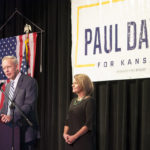Democrats assessing what happened in 2nd District campaign

photo by: Ashley Hocking
Democrat Paul Davis, candidate for the 2nd District of Kansas, speaks to a crowd at the Democratic election night watch party on Tuesday, Nov. 6, 2018 at Maceli’s. Davis is accompanied by his wife, Stephanie.
TOPEKA — Going into the 2018 elections, Democrat Paul Davis looked like he had a clear advantage in the race for Kansas’ 2nd District congressional seat.
He was a well-known candidate who had carried the district in his unsuccessful bid for governor in 2014. And he was running in a year that was expected to be good for Democrats – a “blue wave,” as many were calling it.
Davis had no opposition in the primary, giving him plenty of time to raise money for the general election, and he faced a field of relatively unknown potential Republican opponents.
After the Aug. 7 primary, many people thought things looked even better for Davis because the winner was Steve Watkins, a political novice whom many people even in his own party did not know or trust, and who later was found to have embellished his own resume.
Watkins, however, ended up winning the race anyway, and now Kansas Democratic Party officials are trying to assess what happened and what they can do to prepare for the next race in 2020.
Ethan Corson, executive director of the state party, said in an interview that the race was actually much tougher than it looked on paper.
“The 2nd District is a district that (Donald) Trump won by 19 points,” he said. “That district was only competitive because Paul and his team and his campaign ran a really, really strong race.”
Chris Reeves, the party’s national committeeman, agreed that the district presents a lot of challenges to Democrats.
“What has happened in Kansas is a lot of what’s happened everywhere in the country,” Reeves said. “We’ve kind of Balkanized, which is good or bad. We have larger metros where people who are Democratic progressives tend to migrate to, and that’s what helped turn Johnson County, and even Sedgwick County, which went blue this time around.”
Indeed, Davis did well in the district’s two major urban counties, Douglas and Shawnee. But he lost in all of the other 23 counties, including Crawford County in southeast Kansas, which Democrat Laura Kelly actually carried in the governor’s race.
Corson, however, said that’s not especially unusual in Kansas.
“I think Kansans traditionally have traditionally tended to vote differently in federal races than they do in state races, and I think that is some of what you’re seeing,” he said. “We saw some of that in 2016 when we did much better in state legislative races than we did in federal races.”
“When you get into those federal races, then you get into who’s going to be in control of Congress, Nancy Pelosi, national issues,” Corson said. “I don’t think it was that Gov.-elect Kelly didn’t have coattails. I just think Kansans always have tended to make a distinction in voting a state ballot and voting a federal ballot.”
Another factor in the race, both officials said, was money. Although Davis raised three times as much money as Watkins — $3.4 million, compared to Watkins’ $1.1 million — Watkins had the benefit of outside groups like the Congressional Leadership Fund, which spent $2.6 million on his behalf in the district.
Reeves said he holds the national Democratic Party partially responsible for that, and for not giving the 2nd District as much attention as it gave the 3rd District, where Democrat Sharice Davids ousted incumbent Republican Rep. Kevin Yoder.
“They should have looked at that, and Paul should have been much more flush with resources to actually turn out the vote like Sharice had,” Reeves said. “Sharice had a thousand-plus people out walking and knocking on doors in the final week, and Paul didn’t have that.”
Reeves said additional help from the party could have made a difference, because Davis actually only lost the race by about 4,500 votes.
Watkins also had a powerful endorsement from Trump, who held a campaign rally in Topeka for both him and gubernatorial candidate Kris Kobach, although Kobach ended up losing that race to Kelly.
But it’s difficult to tell how much of an impact Trump’s endorsement may have had. Trump also endorsed Kobach at that rally, and he endorsed 3rd District Rep. Kevin Yoder, both of whom ended up losing their races.
Corson said the state party did not conduct any internal polling to see whether or not the race changed after Trump’s rally in October.
Looking ahead to 2020, Democrats may continue to face the same challenges — Democratic voters isolated in urban areas; big spending from outside Republican groups; and a lack of willingness by the national party to invest heavily in the district.
Democrats also do not have a deep bench, so to speak, of big-name candidates who can immediately step up and run a 2nd District race, not to mention the U.S. Senate seat that will be up for election that year.
But Corson said the next big candidate isn’t always known two years away from an election, and that Watkins, just like Davids in the 3rd District, were completely unknown figures in Kansas political circles two years ago.
“I am absolutely sure that we will have a very, very strong candidate in the 2nd District in 2020, and a very, very strong candidate for U.S. Senate in 2020,” he said.







